Environmental Enrichment makes life better for you and your cat
What would happen if you left your four-year-old kid alone all day with no supervision and nothing to do? There’s no telling what disaster would greet you when you open the front door. You’d likely find wall graffiti in permanent marker–black, of course, tiny faces smeared with lipstick, as is every surface in the bathroom, soiled underpants and maybe a broken small appliance or two…if you’re lucky. No one in their right mind would ever leave a preschooler home alone. Why then, are we surprised when Fluffy, left alone with no activities, wreaks havoc? What Fluffy needs is some environmental enrichment.
If you have an overactive, destructive cat, here are five things you can do make him happier and keep your home interior safe.
#1 Provide Outlets for Normal Cat Behaviors
First of all, “normal cat behaviors” are how cats would act in the wild. Normal feline behaviors include:
- Hunting
- Eating and drinking
- Going to the bathroom
- Exploring
- Sleeping
- Marking territory (facial marking and marking with the claws and urine)
- Climbing
- Scratching
Your exclusively indoor cat may be safe from predators, disease, cars, aggressive cats and dogs and nasty people, but unless you proactively make life a little more interesting for your kitty, it’s going to be a long, but boring and stressful life. In both cats and humans, stress causes any number of health issues. Stressed kitties of suffer from painful feline interstitial cystitis that causes out of the litter box experiences. Stress and boredom also cause behavioral issues like furniture scratching, urine marking, hyperactivity, compulsive behaviors, attention seeking and aggression.
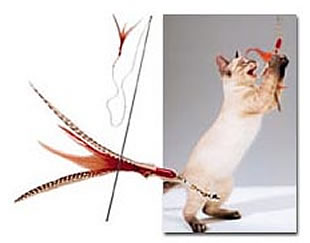
What does he have to be stressed about? While you know he’s safe inside, Fluffy’s brain hasn’t gotten the memo. Instinct keeps him in the I’m-on-the-menu mentality. Boredom and untapped energy breeds destructive behaviors, aggression and stress, which can lead to numerous health issues. Believe it or not, the answer to many of these physical and behavioral problems is environmental enrichment and clean boxes.
Accomodating the cat’s needs
To meet their behaviorial needs, cats should have clean litter boxes, stable scratching posts, cat grass, toys to simulate predatory behavior, and spaces to perch, rest, navigate the home and regular exercise.
I’ll concede, you can’t coax Fluffy onto a rolling treadmill. You can provide him with a good cardio workout by offering him prey on a string (my guys love DaBird), synthetic snake (Cat Dancer Cat Charmer) and bugs (Cat Dancer), Vee Purrfect Feather Cat Toy and Neko Flies Cat Toys. Exercise releases serotonin, a natural brain chemical that reduces stress.
#2 Natural Dining Opportunities
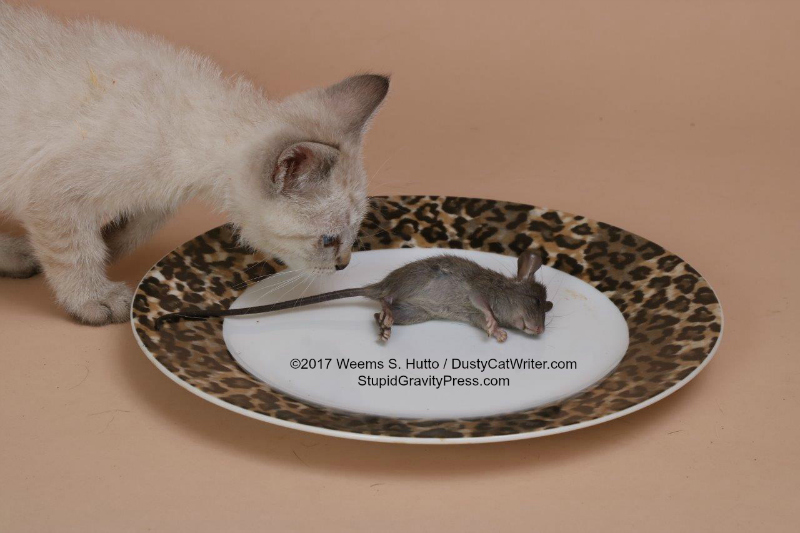 Yes, your kitty eats as much as he wants, whenever he wants. But that’s not a natural behavior. In the wild a cat has to hunt before he can eat. According to cat vet extraordinaire, Margie Scherk, DVM, ABVP, a natural cat kills and eats between five and 10 mice a day. Fluffy will have 15 unsuccessful hunts for every actual meal. That’s a lot of running, jumping, climbing, crouching and leaping.
Yes, your kitty eats as much as he wants, whenever he wants. But that’s not a natural behavior. In the wild a cat has to hunt before he can eat. According to cat vet extraordinaire, Margie Scherk, DVM, ABVP, a natural cat kills and eats between five and 10 mice a day. Fluffy will have 15 unsuccessful hunts for every actual meal. That’s a lot of running, jumping, climbing, crouching and leaping.
“Cats weren’t designed to eat from a trough,” Dr. Scherk says. Instead, make mealtime challenging.
Natural feeding options
My cats love a good food puzzle. They’ll actually pass up a full bowl of kibble to solve the food puzzles we’ve placed around the house. So I was excited when Dr. Liz Bales invited me to give Doc & Pheobe’s Indoor Hunting Feeder system a try. It’s a hunting game that appeals the strategist in your cat and offers food as the reward. It helps satisfy a cat’s natural prey drive. Hide the feeder mice around the house. Fluffy has to locate the mice and then smack them around in order to eat. The set comes with five mouse-shaped food dispensers, a training feeder (to teach your cats how it works), the skin and a portion measure. Each mouse holds enough kibble for a natural mouse-size meal. Formerly known as No Bowl, the feeder mouse is slightly larger than the average field mouse. (I know. I see enough carcasses in my house.) It’s actually the size of an adolescent rat. (See photo above.)
I have to admit, I didn’t follow the training instructions. The Test Kitties are used to problem-solving games, so we jumped right to it. I filled up the mice and distribute them around. In minutes they were kicking them around and retrieving their meal. Between you and me, the holes are so large they don’t present much challenge for my guys, but a piece of duct tape over one of the openings made it more difficult and fun. With multiple cats it’s impossible to monitor food intake, but it’s impossible to do that unless you have assigned seating anyway. Scatter them around the house. Even if you have food guarders, he can’t guard them all at once.
The downsides
The one problem we have encountered is our Pug-mix Burt. (He eats from Petsafe Busy Buddy Kibble Nibble, a food ball.) He had no problem working the feeder mice. We had to set them out dog-free areas of the house. The other problem is keeping track of them. They end up in some very strange places. Some are missing in action. I have a feeling I’ll find a mischief (that’s a group of mice) under the couch. The cats love them. It’s fun to watch the kitties pick up the mouse by the ear or the tail and carry it around. Even with all the things my cats have going on, they like the mouse feeders.
#3 Think 3-D
Unlike humans, free-roaming cats live and work in three dimensions. They monitor animals coming and going from tree branches and seek refuge inside hidey holes. Your inside tiger needs vertical spaces where he can monitor the activities in his environment and get away from annoying dogs or kids. Tall cat trees, cleared bookshelves and window perches can function as Fluffy’s high spots, and enclosed beds, wicker baskets and even cardboard boxes provide hiding places. The more cats you have, the more of these places you need to avoid conflict.
#4 Provide Sensory Stimulation
Cats not only live life multi-dimensionally, they use their enhanced senses of vision, smell and hearing to locate prey. Glenn Olah,DVM, PhD, DABV,P president of the Winn Feline Foundation, says they can “hunt with a minimum light threshold up to 7 times lower than humans.” They can hear much higher frequencies than we can and have an amazing sense of smell to detect prey. These refined senses need to be stimulated.
Making Scents
Use a Comfort Zone® with Feliway® plugin in the areas where your cat hangs out. These plugins contain a synthetic facial pheromone that promotes a feeling of comfort, calmness and tranquility.
Provide a window perch with a bird bath, bird or squirrel feeder to give the kitty his own version of Duck Dynasy. Dr. Olah says, “If indoor cats sense threatening pheromones, or if they cannot express their sensory signals (eg, scent marking), stress-related illnesses and problematic behaviors such as inappropriate elimination or scratching can occur.”
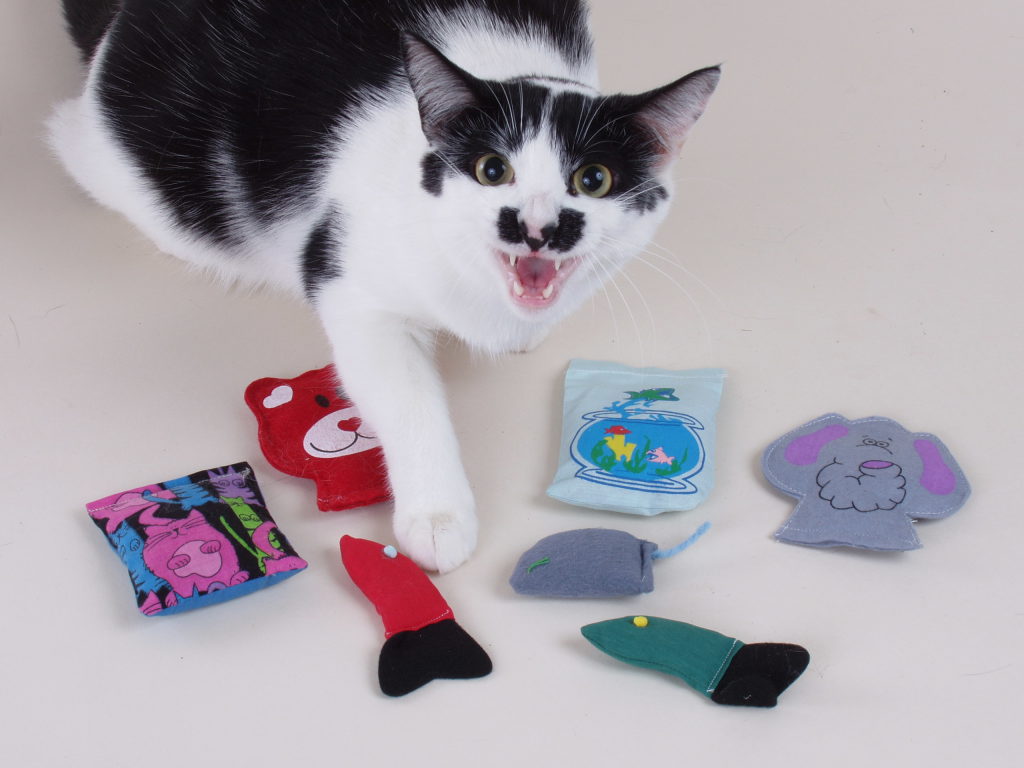
This is where window perches come in handy. As they say, “The best laid plans of mice and men often go awry.” Outside entertainment might backfire if neighborhood cats, dogs or wild animal wander into you yard upsetting your cat. In that case, cat videos and well-secured fish tanks can provide distraction to a bored cat. I occasionally bring home crickets from Petco or PetSmart and let the kitties hunt. Don’t forget catnip toys and even loose catnip. Meowy wowwy!
#5 Cat Friendly Litter Box
In a wild environment a cat would have a perpetually clean litter box. He pees or poops and buried his waste. Next time natures calls, he moves (pardon the pun) to a clean location. Indoor cats don’t have that luxury. They’re dependent on their humans to maintain the bathroom. In nature cats have an unscented sandy medium to eliminate in. Humans put all kinds of unacceptable junk in the box because either we humans like it or it makes us feel ecologically responsible. But cats are very sensitive to textures and scents. (You’ve heard the saying, “Happy wife, happy life.” This one goes, “Happy kitty, happy carpet.” Here’s what makes kitties happy with their litter box:
- Large open litter box that measures at least 1.5 times your cat’s body length.
- One box for every cat plus one
- Place boxes in different areas of the house, not next to each other
- Place boxes only in quiet areas and don’t let kids or dogs bother the cat while he’s in his box
- Don’t place boxes next to food or water bowls
- Use unscented, sandy textured litter
- Avoid pellets, and scented litter
- Scoop daily, better still, twice a day.
What kind of environmental enrichment you provide for your cat? Please tell me in the comment section below.










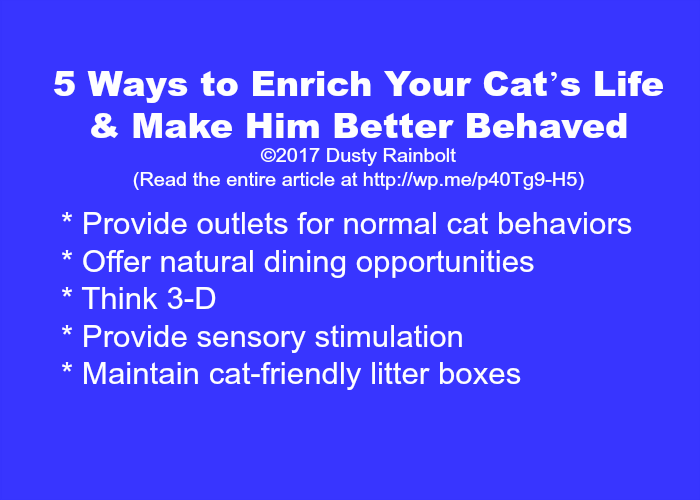
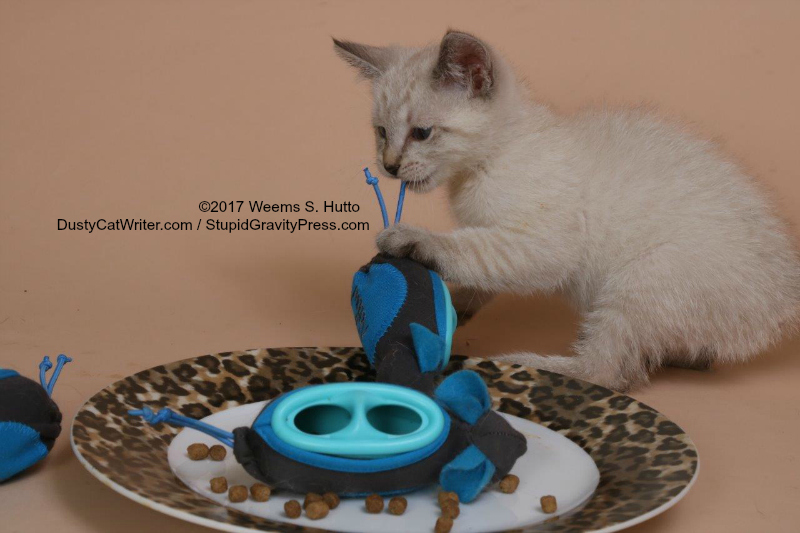
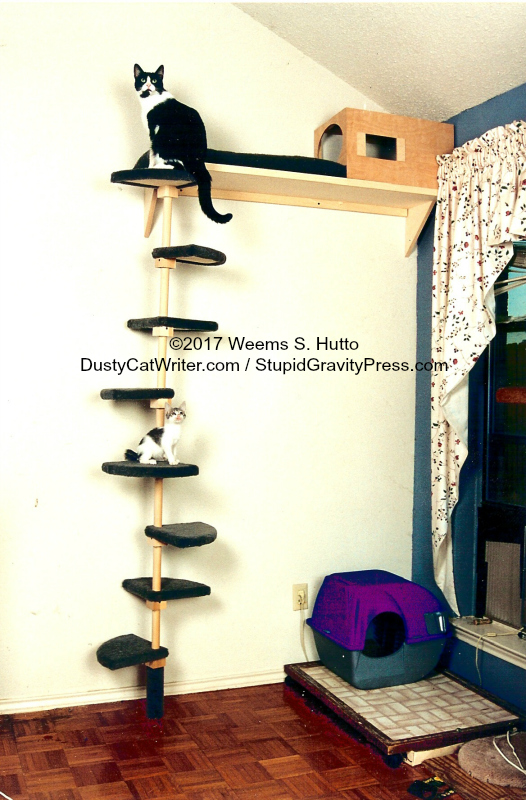

I like to bring home “feeder” fish from Petco or PetSmart and place them in large shallow baking dish. I place the dish on the floor and call “fishing time” and most everyone comes running.
I started doing this years ago (don’t ask how many, Dusty, lol!) and I’ve only had a few who didn’t quickly become master fishercats. A couple even caught and shared with those who weren’t able or not interested in the fishing experience.
I’ve had aquaria running many of those years and while I occasionally have had problems with unauthorized expeditions in the tanks, they haven’t been ones which couldn’t be easily resolved. Keeping your own tanks also ensures a ready supply of fish! I recommend mollies and swordfish. They will interbreed, providing some interesting colors which are easy to track and catch. Guppies are also fast producers, but harder for kitties to catch because of their size. Also, you may decide you find them too pretty to sacrifice!
I have several Nerf air guns which shoot fairly sturdy, slightly smaller than a ping pong ball, balls. Spray catnip on the balls and store them in a plastic container. I keep a gun and container by my bed for those middle of the night and dawn attacks so I have a decent distraction. Just be sure you don’t make a habit of shooting them or you will find kitty has trained you. I also keep gun/container combos scattered around the house. The catnip is the deal sealer with this particular entertainment.
Stuffed animals are wonderful toys and encourage the hunter instinct.
Placing a padded, fabric covered board on the wall provides a straight up climbing experience. The board should be at least six inches wide, though I’d go with a foot. Make sure the fabric is one which isn’t as likely to catch and hold claws. Mine start about a foot and a half off the floor and run to just below the ceiling.
Ping pong balls, wiffle balls, hacky sacks, rubber jacks and balls are all excellent fetching toys. So are the smaller stuffed animals. Lots of bath toys work well also.
Cut an entry into a sturdy cardboard box and suspend it from the ceiling with a few other small holes cut out and watch. It should hang a few inches off the floor after your cat is inside. This is a great multi cat game.
As always, thanks for the great article Dusty!
What great suggestions. Thank you so much.